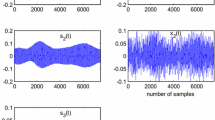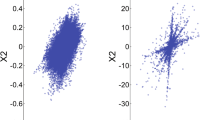Abstract
Recently, sparse component analysis (SCA) has become a hot spot in BSS research. Instead of independent component analysis (ICA), SCA can be used to solve underdetermined mixture efficiently. Two-step approach (TSA) is one of the typical methods to solve SCA based BSS problems. It estimates the mixing matrix before the separation of the sources. K-means clustering is often used to estimate the mixing matrix. It relies on the prior knowledge of the source number strongly. However, the estimation of the source number is an obstacle. In this paper, a fuzzy clustering method is proposed to estimate the source number and mixing matrix simultaneously. After that, the sources are recovered by the shortest path method (SPM). Simulations show the availability and robustness of the proposed method.
Similar content being viewed by others
References
He Z S, Xie S L, Fu Y L. Sparse representation and blind source separation of ill-posed mixtures. Sci China Ser F-Inf Sci, 2006, 49(5): 639–652
Hyvarinen A, Oja E. Independent component analysis: algorithms and applications. Neural Netw, 2000, 13(4–5): 411–430
Tan H Z, Chow T W S. Blind identification of quadratic nonlinear models using neural networks with higher order cumulants. IEEE Trans Ind Electron, 2000, 47(3): 687–696
Liu Y D, Zhou Z T, Hu D W, et al. A novel method for spatio-temporal pattern analysis of brain fMRI data. Sci China Ser FInf Sci, 2005, 48(2): 151–160
Xie S L, He Z S, Fu Y L. A note on Stone’s conjecture of blind separation. Neural Comput, 2005, 17: 245–319
Li Y Q, Amari S, Cichocki A, et al. Underdetermined blind source separation based on sparse representation. IEEE Trans Sig Proc, 2006, 54(2): 423–437
Belouchrani A, Cardoso J F. Maximum likelihood source separation for discrete sources. In: Proc EUSIPCO. Edinburgh, 1994. 768–771
Zibulevsky M, Pearlmutter B A. Blind source separation by sparse decomposition in a signal dictionary. Neural Comput, 2001, 13(4): 863–882
Bofill P, Zibulevsky M. Underdetermined source separation using sparse representation. Sig Proc, 2001, 81: 2353–2362
Li Y Q, Cichocki A, Amari S. Analysis of sparse representation and blind source separation. Neural Comput, 2004, 16(6): 1193–1234
Lewicki M S, Sejnowski T J. Learning overcomplete representations. Neural Comput, 2000, 12: 337–365
He Z S, Xie S L, Ding S X, et al. Convolutive blind source separation in the frequency domain based on sparse representation. IEEE Trans Audio Speech Lang Proc, 2007, 15: 1551–1563
He Z S, Xie S L, Zhang L Q, et al. A note on Lewicki-Sejnowski gradient for learning overcomplete representations. Neural Comput, 2008, 20(3): 636–643
Wax M, Kailath T. Detection of signals by information theoretic criteria. IEEE Trans ASSP, 1985, 33(2): 276–280
Ye J M, Zhu X L, Zhang X D. Adaptive blind separation with an unknown number of sources. Neural Comput, 2004, 16(8): 1641–1660
Zhang H Y, Jia P, Shi X Z. Determination of the number of source signals in blind source separation by singular value decomposition (in Chinese). J Shanghai Jiaotong Univ, 2001, 35(8): 1155–1158
Li G B, Xu S M. Blind source separation based on signal number estimation (in Chinese). J Syst Simul, 2006, 18(2): 485–488
Zhang Y, Ke H Y, Wen B Y, et al. A new method to estimate signal number by echo’s phase(in Chinese). Wuhan Univ J (Nat Sci Ed,), 2003, 49(1): 137–140
Zhang X H, Zhang A Q, Sun J P. A blind method for estimating the number of signal sources (in Chinese). Syst Eng Electr, 2001, 23(9): 9–11
He Z S, Xie S L, Fu Y L. Sparsity analysis of signals. Progress Nat Sci, 2006, 16(8): 879–884
Lv Q, Zhang X D. A unified method for blind separation of sparse sources with unknown source number. IEEE Sig Proc Lett, 2006, 13: 49–51
Yang L B, Gao Y Y. The theory and application of fuzzy mathematics (in Chinese). Guangzhou: South China University of Technology Press, 2002. 86–125
Author information
Authors and Affiliations
Corresponding author
Additional information
Supported by Key Program of the National Natural Science Foundation of China (Grant No. U0635001), the National Natural Science Foundation of China (Grant Nos. 60674033 and 60774094)
Rights and permissions
About this article
Cite this article
Yang, Z., Tan, B., Zhou, G. et al. Source number estimation and separation algorithms of underdetermined blind separation. Sci. China Ser. F-Inf. Sci. 51, 1623–1632 (2008). https://doi.org/10.1007/s11432-008-0138-6
Received:
Accepted:
Published:
Issue Date:
DOI: https://doi.org/10.1007/s11432-008-0138-6




